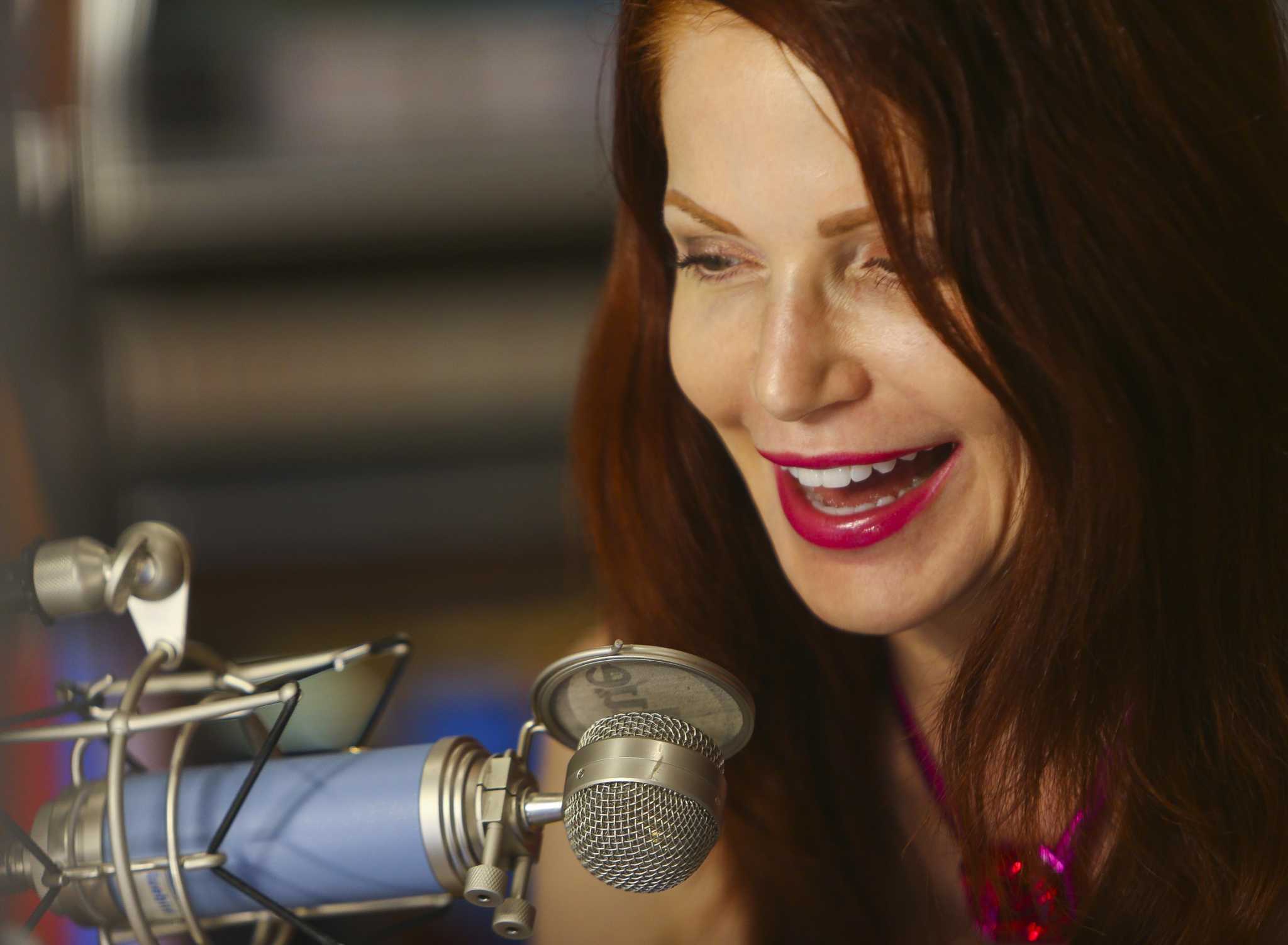Spheres of influence: Houston woman shares her Flat Earth gospel via YouTube

She’s got a wall full of records behind her and a Wurlitzer jukebox in the corner. Her magenta lipstick is neatly applied in place like a 1950s model. She has an old school radio mic pencil holder on the desk and rich red hair that looks like it came straight out of a Kodachrome photograph.
But despite the decidedly retro vibe, when the video for her YouTube channel starts streaming from the laptop, Steere talks about a rather contemporary issue: The idea that the Earth is different than what we’ve been told.
In addition to being a woman with impeccable taste for interior decorating in her Heights home, Steere also is a Flat Earther. That is, she really and truly believes the Earth is flat.
And she’s not alone.
In the age of alternative facts and internet factions, the belief in a flat Earth seems to be enjoying a modern renaissance. NBA star Kyrie Irving went on Jimmy Kimmel’s late night show to probe the planet’s nonspherical shape, and rapper B.o.B. launched a GoFundMe to debunk the globe theory. It was even a topic for “The Bachelorette.”
Where once it was a lone voice in the night spreading fringe beliefs on AM radio, there are now YouTube channels, national conferences, in-person mixers and Facebook groups with thousands of followers, all devoted to sharing their latest insights on the cracks in scientific knowledge.
More Information
Flat Earth theories
There’s no unified agreement on what Flat Earthers believe when it comes to the exact layout of the cosmos.
Some believe there’s a wall — possibly what we call Antarctica — circling around the edges of the planet. Then, the sun and the moon would be flat lights above, moving around the heavens in circles. Day happens only when the sun is overhead.
Others believe there’s a hole in the middle of the disclike surface of the planet. Still others believe we all live on a flat planet covered by a dome.
Some — despite being so-called Flat Earthers — aren’t actually attached to the idea that the Earth is flat. Instead, they just contend that it’s not a globe. Maybe it’s a diamond or a cube.
Typically, Flat Earthers don’t believe in the moon landings and, often, they discount gravity. Satellites are fake, many say, and GPS systems are run from the tops of buildings.
— Keri Blakinger
To Mark Fenster, a University of Florida law professor who authored a book on the topic, none of this is a surprise. Rather, it’s part of a regular cycle in American populist thought.
“There are moments at which people are more willing to believe in conspiracy theories,” he said.
Right now, it seems, is one of them.
“I don’t look like an insane Flat Earther,” Steere says with a smile.
A former boutique owner now living off inheritance and savings, Steere makes proselytizing the Earth’s true shape almost a full time job on her YouTube channel — The Flat Earth and Other Hot Potatoes — which boasts more than 13,000 subscribers. She’s quick to explain that it’s not a good income — YouTube revenue streams are but a trickle when you’re playing to fringes. But thrice weekly web shows, travel for conferences across the country, media interviews and, of course, research all adds up to a 40-hour-a-week gig.
She “doesn’t participate” in politics, believes global warming and gravity are both lies, questions whether nuclear bombs really exist, decries chemtrails, has doubts about the safety of vaccines and is utterly certain the moon landing was faked.
“I call myself a conspiracy realist,” she said. “There really are conspiracies going on.”
In debate, she pulls from a large stock of material she sees as evidence, tossing out scientific-sounding claims about the Coriolis effect, the stability of the star Polaris as a reference point, the makeup of moon rocks and the behavior of gyroscopes during plane flights.
One of her go-to demonstrations of the Earth’s nonspherical shape: The existence of oceans.
“Water cannot conform to a shape like a ball,” she said. If the Earth were a globe, she explained, all the water would fall off.
Sure, some people explain the continued existence of massive, flat bodies of water through the force of gravity’s continual tug. But Steere disputes the existence of gravity altogether.
“This,” she said, dropping a cup holder, “drops because it’s heavier than air.” It’s the weight, she explained, not the gravity that causes objects to fall to the ground instead of floating in the air. Scientists say that weight is created by the invisible force of gravity, tugging objects down and making mass feel heavy. Steere does not agree.
“It’s called the theory of gravitation,” Steere replied. “It’s a theory.”
Flat Eartherism is — clearly — not new. Just recall those elementary school lessons about how early European explorers feared their ships would fall of the edge of their flat world.
But now, experts say, the belief is driven by different forces than it was 1,000 years ago — things like so-called “future shock” and other ideas that buoy nonscientific beliefs and broader conspiracy theories.
“It’s a little bit of a feeling that science has not delivered the goods,” said Andy Hines, an assistant professor and coordinator at the University of Houston’s Foresight Program. “Progress is amazing, but maybe it’s a little bit of worshipping the false god.”
That is, even though science and technology have offered stunning advances like cell phones and the internet, they haven’t fixed other science-based problems like global warming or cancer.
“It’s not enough to have the right technology; there’s all this messy human element,” Hines said “Even though science and technology has delivered, it hasn’t fixed this. So in a sense it becomes a little bit of a target.”
But offbeat beliefs also gain traction because the tales they tell feel true, said Keith Livers, a University of Texas at Austin associate professor who has studied conspiracy theories.
“Belief systems are not based on logic, but in many cases the conspiracy theories are stories that are told that resonate with people’s lived experiences,” Livers said.
By way of example, he points to the aftermath of Hurricane Katrina, when widely circulated conspiracy theories claimed that it was actually the government — not the storm — that had destroyed the levees in New Orleans.
“They didn’t,” Livers said, ensuring the clarity of his point. “But the story is not untrue in that it resonates with people’s experience of decades of neglect in the African-American community. So it’s not factually true but it does resonate with people’s lived experience.”
So, how does that apply to Flat Earthers?
“It might be an attempt to recapture some sense of a world or reality that’s more manageable, and in that sense it’s a metaphor — they’re implicitly suggesting there was this sort of pristine flat Earth reality that we can recapture,” he said. “It’s not that they’re crazy, it’s that they’re articulating narratives that confirm their experience.”
Ever since she was a young child, Steere had a feeling that the world didn’t make sense. The country was at war and there was talk of nuclear threats. And it all seemed so far-fetched.
Growing up in Kalamazoo, Mich., her mother was a sociologist and her father owned a radio station. It was there she launched her broadcasting career. “I started off working the graveyard shift for him,” she said.
Steeped in the late-night radio lore of conspiracy captain Art Bell, she was a DJ patrolling the airwaves from 7 p.m. to midnight, playing vinyl on an AM station. She learned about chemtrails (the idea that airplane exhaust paths contain chemicals that rain down on us), veganism and natural health remedies.
When her father sold the station, Steere struck out on her own, following radio jobs across the country before settling down in New Orleans and later opening a boutique. But in 2014, her mother died, she sold the store and relocated to Texas, looking to start anew.
A year later, while surfing the internet, she discovered the Earth was flat.
One day, in January 2015, Steere was researching the moon landing — faked, she says — when she stumbled across a series of videos with a title that intrigued her: “Flat Earth Clues.”
“They captured my imagination,” she said. “But not only that, they started me thinking about why I believe the things I believe. And realized that beings free of beliefs is the goal.”
She kept clicking and surfing, plumbing the depths of YouTube in a search for more nonbeliefs.
By August of that year, she’d launched her own channel, streaming her radio-ready voice discussing issues and context in the flat Earth debate.
Conspiracy believers have always been around. In contemporary times they’ve questioned the reality of the Sandy Hook shooting and lobbed theories about the JFK assassination that include a second shooter or a magic bullet. For decades, even centuries depending on the conspiracy, these ideas stayed alive in books, late-night talk radio and cable TV specials. But now, in the age of the internet, they’re able to come together in a way they weren’t able to even 20 years ago, congregating in silos of like-minded thought outside the mainstream.
“They’ve probably always been around in isolated pockets, but they could never find each other,” says Hines, the UH professor. Now they can. And the recesses of the internet are a perfect medium for breeding offbeat niches of thought.
“Post-modern relativism says that my truth is as good as your truth,” Hines said. “It’s the coming to fruition of this long-term trend that says truth is relative.”
And while Flat Earthers may not ever constitute a mainstream ideology, as long as people want to “check out” of society, and have the means to come together to do it, the trend could persist.
“In order for these belief systems to wither away naturally — and you can’t fight them by appealing to logic — the only way to address them would be to address the conditions that have produced the belief, and there’s not any indication that we’re going to do that,” said Livers, the UT professor. “Conspiracy only flourishes when there is fertile ground, when there are conditions conducive to people believing that they’ve been massively disenfranchised and that they’ve lost agency.”
But to Fenster, the current uptick is just part of normal ebb and flow of history.
“In the U.S., there is a fairly consistent belief in the existence of conspiracy theories among a core group of folks who are thoroughly committed to them. The trend lines can sort of jump up or down a little bit,” the Florida professor said. “It’s just that it’s more of a wave than a diagonal lineup.”
Right now, Steere is riding that wave from inside her well-decorated home in the Heights.
But even as a true believer — or true nonbeliever, as it were — sometimes she finds herself at the center of bizarre internet theories.
“There’s conspiracies out there about me,” she said. “That I live in an underground bunker. That I’m a man. That I’m a 90-year-old former supermodel with lots of plastic surgery and a prosthetic face. I’m a clone. I’m a paid agent.”
She certainly understands the impulse to theorize and seems unfazed, wrapped in the confidence of her conviction. Still, as is often the case with female internet presences, some of the harassment is pointedly gendered, and a bit more strident and regular than the insults lobbed at her male peers.
And some of it’s coming from her own side of the Flat Earth debate. Though, at least, she knows there’s a limit.
“They can’t ever say that I’m an alien from another planet,” Steere said. “Because we don’t believe there are other planets.”
keri.blakinger@chron.com
*** This article has been archived for your research. The original version from Houston Chronicle can be found here ***


